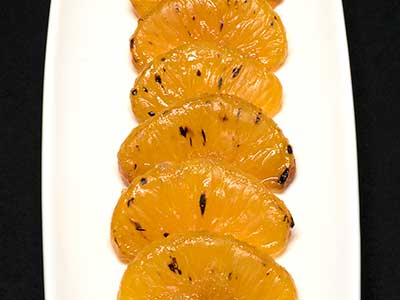April 13, 2015
Intermède

mandarine confite
(candied mandarin)
The part we eat is called the endocarp. Each segment in the endocarp is a carpel. Each carpel is made up of small, individual juice-filled follicles or hairs. Each follicle is an individual cell quite visible with naked vision. No microscope required. It’s quite easy to look at the individual cells of an orange before we slurp them up. The carpel is what us ordinary people call a segment and chefs call a supreme.
The membrane that surrounds each carpel is high in pectin, a polysaccharide, but it is also a bit fragile. Expose the carpel to heat, and it balloons out, bursting the outer membrane. As was demonstrated in the half-dried tomato recipe, introduce a little calcium to the pectin, and it readily crosslinks, becoming quite sturdy. With a little cross-linking of the outer membrane, making orange segments that can be served warmed should be simple. It is.
I would love to claim credit for this idea, but I can’t. On January 1st, 2012, the concept was published on the Ideas in Food website. My version is a bit simpler, but the idea belongs to them.
To prepare this dish you’ll need the citrus fruit of your choice. I used a tangerine that was labeled in the market as a mandarin. I prefer tangerines or similar fruits for this type of dish because the segments are a snap to harvest without damaging the segment membranes. Soak the segments in a one-percent calcium hydroxide solution for about an hour. The membranes will become noticeably firmer. Rinse the segments in multiple changes of water. When you think the segments are well rinsed, do it a few more times.
Just before service, roll the segments in finely granulated sugar. Shake off any excess, and arrange the segments on a small, uncoated baking sheet. Place the baking sheet over a heat-proof surface. Do not line the sheet with foil or paper. Use a butane torch at full gas volume, but with the nozzle set at its least intensive setting, to quickly torch the whole surface of the each segment. Move the torch rapidly. Stop when brown spots begin to appear on the segments. Move the segments as necessary.
Serve warm.
© 2015 Peter Hertzmann. All rights reserved.
